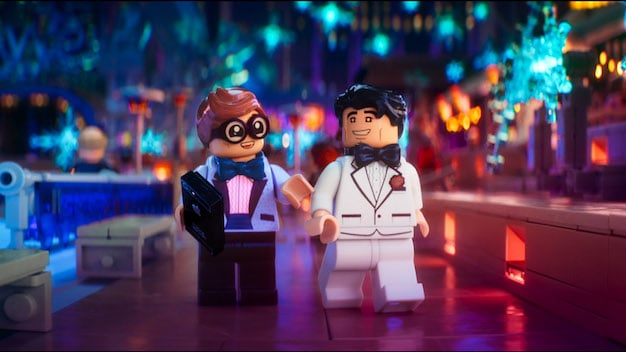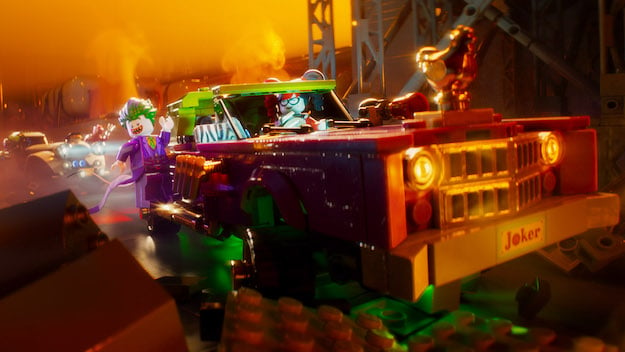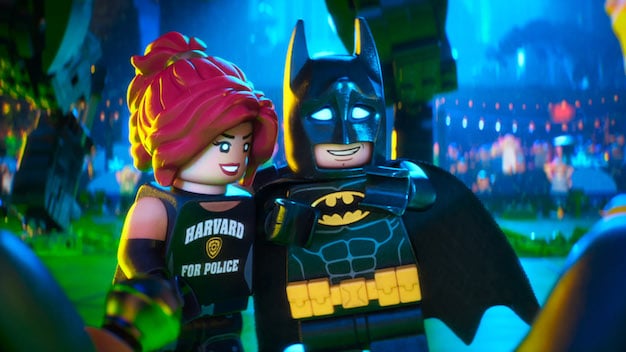Deep Focus: The Lego Batman Movie

If you feel like being tickled to death with a high-tech version of a feather duster (and there are worse ways to go these days), The Lego Batman Movie is the film for you. As for me, after 45 minutes my funny bone became insensate. Either that, or the laugh-activation center of my brain fizzed out. It was as if the movie collapsed under the burden of its own weightlessness: the unbearable lightness of plastic being.
The hundreds of millions of fans who saw The Lego Movie (2014) know roughly what to expect: wisecracks, physical gags, and pop-culture parodies shot from a circus super-cannon while the filmmakers concoct wild farcical fantasias out of little Lego bricks. This time, Phil Lord and Christopher Miller, the Lego Movie’s writing-directing team, hand the directing reins over to Chris McKay, who is credited as an editor and animation co-director and supervisor on the original smash. McKay’s visual inventiveness keeps pace with the madcap storyline, which involves the Joker (Zach Galifianakis) trying to convince Batman (Will Arnett) that he really is the Caped Crusader’s arch-villain, not merely another one of Gotham City’s “rogues.” These include not just predictables like Bane (Doug Benson) and Harley Quinn (Jenny Slate) but that squirty felon The Condiment King, who threatens to smother his enemies with ketchup and mustard. (Four writers are credited with the script.)
Along the way, the movie depicts Batman as a psychotic loner posing as a fulsome hero, and Bruce Wayne, his alter ego, as a childish narcissist disguised as a glad-handing extrovert and philanthropist. Even though he lives on his own island, Wayne Island, in his own manor, Wayne Manor, Wayne must learn that no man, or Batman, is an island.

Part of the film’s fun is its genial ridicule of the Batman mythology through the ages, including the idea that Batman launches his supposedly covert missions from the BatCave right underneath Wayne Manor. Arnett’s growl never ceases to amuse, even when he’s mouthing Deadpool-like meta-snipes on the soundtrack about, say, how very important movies always begin with a black background. (Is he talking about you, Christopher Nolan, or did those Batman films, like Zack Snyder’s Batman v Superman, simply leave the impression of starting dark and staying dark?)
The franchise’s deluxe brand of digital mock stop-motion, which makes it seem as though the filmmakers were constructing a universe of real tiny blocks in a palette as vivid as a vintage Colorforms set, is marvelous—until it becomes relentless, then monotonous. The Lego Batman Movie contains moments of genuine comic lunacy: the Joker’s face changing expression with decals applied like graffiti; Batman body-slamming himself up and down Wayne Manor’s staircase like a three-year-old in a tantrum. But The Lego Batman Movie mostly proves that this franchise has already descended into a disappointing formula. These movies flash a subversive hook, then straighten it out as they streak along.
The Lego Movie got its spine from the running joke that the Special One who was destined to bring down the vile Lord Business appeared to be a super-ordinary Lego mini-figure named Emmet, a joyous conformist who lived by the book—an all-inclusive instruction manual that taught him to treasure routines. What sustains the humor and keeps it generous is how often the moviemakers find ways to turn Emmet’s clumsy vacuity into an advantage. But that film gets all soft and cuddly (itself a feat, I suppose, for a movie made of Lego bricks) as Emmet becomes a paragon of plucky innocence and teamwork. It’s as if the filmmakers suddenly became over-protective teachers (or very savvy marketers), awarding an equal number of gold stars to mediocrities and geniuses. And they ultimately landed in a bog of we’re-all-special messages and family-film cuteness and sentimentality.

The Lego Batman Movie spins its own slender thread of a through-line from Batman/Bruce Wayne’s realization that he’s an isolated anger freak whose fury derives from the murder of his parents; he moons over a family photo taken right before their death on a block conveniently named “Crime Alley.” His butler, Alfred Pennyworth (Ralph Fiennes), tries as hard to be accepted as Batman’s surrogate father-figure as the Joker does to be recognized as the Dark Knight’s ultimate bad guy. Batman becomes aware of his need for family, or for friends who are as close as family, only after two new caped companions enter his life: Dick Grayson/Robin (Michael Cera), his ward, and Barbara Gordon/Batgirl (Rosario Dawson), who is also Gotham City’s new police commissioner. The prime farce of The Lego Batman Movie arises from Batman’s inability to give an atta-boy to his confreres without making it sound like self-praise. Still, by the end, they’re just one big happy BatFamily.
The obvious comparison is to The Naked Gun movies and TV series and Top Secret and Airplane!, in which the ZAZ team’s most outlandish strokes grow naturally out of the far-fetched yet stock plots. The fellows behind the Lego movies are more like manic doodlers, which better suits The Lego Movie’s more open, action-movie form. About halfway through, superhero tropes short-circuit the freewheeling hijinks of The Lego Batman Movie. Why did the filmmakers feel they had to anchor their runaway wit to the dead weight that was Batman vs. Superman? It’s mildly enjoyable to hear Batman tell the Joker that for him the primal villain may be Superman, but a viewer must be part of the DC Universe’s captive audience to think it bears repeating, and repeating. The movie oscillates wildly between gags so specific that they enthrall Batman’s fan base and so general that they pander to anyone who’s punched a ticket to a Harry Potter, Lord of the Rings, or Godzilla movie or thrill ride.
The eye-popping animation may win over Batcolonies around the world, but the key vocal performances are what carry the movie. They’re so note-perfect they even ratchet up the hilarity of the sight gags. The remarkable Mr. Fiennes brings a tinge of self-knowledge to Alfred’s staunch, long-suffering sensibility, so it’s hysterical when we see Alfred reading a book called Setting Limits on Your Out-of-Control Child. Cera’s piping voice—the aural equivalent of Keene eyes—is perfect for Dick Grayson, who looks up to Bruce Wayne as “the greatest orphan of all time,” and for Robin, so tickled at the prospect of having a second dad, Batman, that he can’t seem to figure out why both men live in the same house. Dawson imbues Gordon with her robust, nonchalant confidence. Unlike her outgoing commissioner-father, this police commissioner, a star graduate of the “Harvard of Police” (yes, that’s the name of the academy), feels that she has more tools to attack crime in Gotham City than simply flipping on the BatSignal. Her delivery is both matter-of-fact and alluring in its fresh air of command. You can see why Bruce Wayne would be angered and attracted enough to introduce himself to her as “billionaire, bon vivant, Gotham City’s most eligible bachelor, like, 90 years in a row.”

As my examples might reveal, I think Lego Batman soars when it cuts the traces of other superhero movies or ribs them without mercy. The richest sources of satire are its dual characterizations of Batman as a fantasy version of Donald J. Trump, who is under the delusion that he can fix Gotham carnage all by himself (shades of “I alone can fix it”), and Gordon as a two-fisted, straight-talking Hillary Clinton, who argues that “it takes a village, not a Batman” to stop super-villains like the Riddler (Conan O’Brien) or Two-Face (Billy Dee Williams) or, yes, the Joker. (Steve Mnuchin, Trump’s pick for Secretary of the Treasury, is one of the executive producers; he also gets that credit on Mad Max: Fury Road.) It’s upsettingly funny to think of Trump as Batman puts his Bat-brand on everything, shoots gifts to orphans from his merch gun, and takes credit for any feat of crime-fighting that occurs within a 100-yard radius, especially when the real hero is Robin. It’s diverting (and, let’s face it, a little saddening) to think of Clinton as the smart, pragmatic Gordon, who’s eager to take advantage of anyone’s good points, even Batman’s. She believes, incredibly, that they’d be stronger together.
What’s unexpectedly brilliant about this political burlesque is that when it focuses on the Batman-Joker dynamic rather than the Batman-Batgirl conflict, the Joker is more like Trump and Batman is more like Obama. The Joker thinks he has Batman caught in a trap: “Save the city or catch your greatest enemy.” Batman is incredulous: “You think you’re my greatest enemy?” Impatiently, he explains to the Joker, “I don’t currently have a bad guy, I am fighting a few different people.” This face-off resembles the tense comedy-drama underlying the 2011 White House Correspondents Dinner. Batman’s casual riposte recalls Obama giving a withering shout-out to Trump after finalizing plans, that very weekend, to take down Osama bin Laden. When Batman tells the Joker, “You’re a clown who means nothing to me,” he’s like Obama telling the tycoon, to his face, with dripping irony, that when the men’s cooking team on Celebrity Apprentice did not impress the judges from Omaha Steaks, “you, Mr. Trump, recognized that the real problem was a lack of leadership. And so ultimately, you didn’t blame Lil Jon or Meatloaf. You fired Gary Busey. And these are the kind of decisions that would keep me up at night.” Obama’s final line to Trump is often forgotten: “Say what you will about Mr. Trump, he certainly would bring some change to the White House.”
The Joker gets back at Batman by unleashing the evil forces of the Phantom Zone—temporarily. And we know who darkens the halls of the White House now that Obama has left office. I’m not thrilled or elated by The Lego Batman Movie, but I guess what most intrigues me about this film is its frightening realism.
Michael Sragow is a contributing editor to Film Comment and writes its Deep Focus column. He is a member of the National Society of Film Critics and the Los Angeles Film Critics Association. He also curates “The Moviegoer” at the Library of America website.







